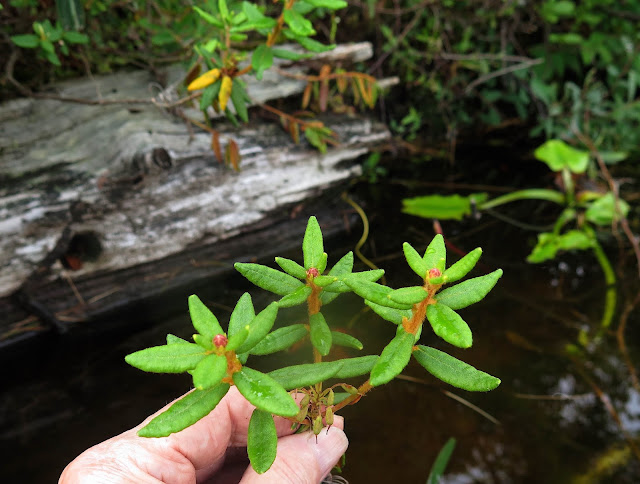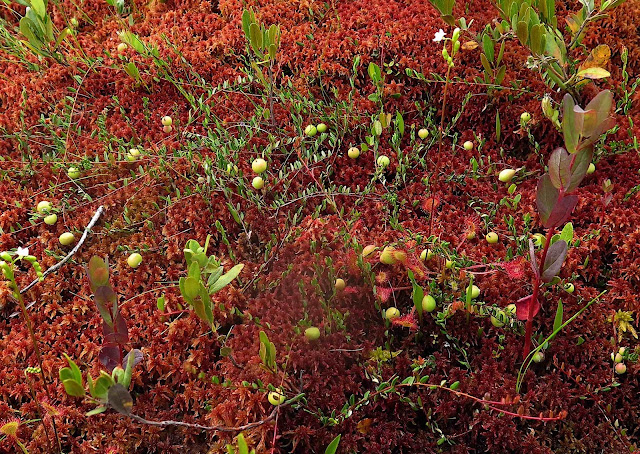In just a few days, I'll be heading to the beautiful Caribbean island of St. Lucia, where I can immerse myself in the tropical flora that I've heard is lush and lovely there. I can't wait! (Especially since I'll have lots of time there to spend with beloved family.) But before I go, I was glad to immerse myself in the lush and lovely flora of a lake in northern New York. And this particular lake, located in the southeastern Adirondack region, is remarkable for the acres and acres of floating bogmat that add enormous botanical treasure to this quiet lake where speedboats are not allowed and the few homes that occupy its shores are well hidden from view. I joined my friends Ruth Brooks and Sue Pierce to explore this fabulous place today, and lucky for us, we had a whole day without rain!

Before I headed out to explore the bogmats, I eased my little canoe close along the shore, which was thick with the species of shrubs that prefer an acidic habitat. Probably the single most populous shrub was Sheep Laurel (Kalmia angustifolia), which still sported a few bright-pink flowers among its branches now mostly holding fat round clusters of seeds.
Because of rocks under the water, I could not push my canoe close to shore to more closely enjoy the few Sheep Laurel blooms that remained, but my camera's zoom could bring images of them closer to my eyes.
Labrador Tea (Rhododendron groenlandicum) is a second shrub common along this shore. Although it, too, was past its blooming season, the small pink buds containing next spring's flower clusters were quite pretty in their own way. Note the orange fuzz that covers the twigs and the undersides of the leathery aromatic leaves, a very distinctive trait of this denizen of northern bogs and fens.
Unlike those two flowering shrubs, the aquatic wildflower called Pickerel Weed (Pontederia cordata) was in its purple-flowering glory, with vast patches of it lining the shores of a quiet backwater.
And here was a spectacular patch of one of New York's prettiest orchids, called Rose Pogonia (Pogonia ophioglossoides), that was occupying a moss-covered log that had fallen among the Pickerel Weeds. Such a lovely color combination, the small pink orchids and the vibrant purple aquatic flowers!
Here is a closer look at two of those Rose Pogonias.
In this quiet and shallow backwater, many fallen logs serve as nursery beds for an amazing variety of plants, including this lush green moss and the sparkly red leaves of Round-leaved Sundew (Drosera rotundifolia). The sundew had raised its long curling flower stems, and a few of its tiny white flowers had already opened.
While peering more closely at the remarkable insect-attracting-and-devouring pads of the Round-leaved Sundew, I happened to spy a patch of lime-green Sphagnum Moss that was profusely studded with the small reddish-brown capsules of its fruiting bodies.
Flat oval pads of Water Shield leaves (Brasenia schreberri) rested on the quiet water, and dozens of its pretty pink flowers stood erect above the water's surface.
And of course, there were Fragrant Water Lilies (Nymphaea odorata) floating their pure-white blooms on the water, as well as Yellow Pond Lilies (Nuphar variegata) holding their globular golden blooms well above the surface.
I could not remember ever having seen these remarkable-looking pods forming atop the Yellow Pond Lilies' stalks. How colorful and with such an interesting shape!
I recall seeing three Northern Pitcher Plant flowers (Sarracenia purpurea) in exactly this spot a year ago, and it looks as if this year a fourth flower is hoping to join the party.
Both the leaves and the flowers of Northern Pitcher Plant are remarkably shaped and colored. I was quite delighted to find this "family group" of leaves: Papa, Mama, and some young'uns of different sizes! I also loved the clear gold color of the Sphagnum Moss they were growing in. The pitcher-shaped leaves do hold water, which also contains certain enzymes that dissolve any unfortunate insect that happens to fall in, a process that provides nutrients to the plant.
After exploring the quiet backwaters to our hearts' content, Sue and Ruth and I headed out to explore the bog mats. Our small Hornbeck solo canoes are just the right size for nudging into the narrow channels and rounding the curves of passages through the bog mat. This is Ruth in her Kevlar canoe.
And this is Sue, in her carbon-fiber Black Jack, which is similar to my own canoe.
When we visit this lake in the fall, the mountains that ring the lake are a marvelous crazy quilt of gorgeous colors. Today, the bog mats themselves were remarkably colorful.
The Sphagnum Moss that carpets the mats comes in shades of scarlet and gold, and sometimes the colors are mixed together, like those in a Persian carpet.
This patch of scarlet moss was adorned with the pale green orbs and slender leafy vines of unripe Small Cranberries (Vaccinium oxycoccos).
I had never before seen Horned Bladderwort (Utricularia cornuta) in such abundance, with masses of this yellow-flowered plant spreading across the mossy bog mats.
The small pink flowers of Marsh St. John's Wort (Hypericum virginicum) won't bloom until later this summer, but the plants are already quite colorful, sporting leaves with undersides that appear quite vividly purple.
The red, green, and golden colors that predominate on the bog mats are repeated in such small packets of beauty as this green-and-gold mossy mound atop a fallen log that is adorned with Spatulate Sundew (Drosera intermedia) and a red sprig of Marsh St. John's Wort.
As autumn approaches, the Sphagnum carpets will be studded with the ruby-red orbs of Large Cranberries (Vaccinium macrocarpon), whose dainty flowers -- some pink and some white -- were much in evidence today.
I am so happy we had this one non-stormy day this week, so that I could delight in these local beauties with my dear friends before leaving for the tropics. I'll be gone for about two weeks, and traveling without computer, so farewell to my dear readers for this brief time. I AM taking my camera, so look forward to a few photos of an entirely different flora next time we meet.























5 comments:
Oh my word! What a trip, with so many sights to see! Thank you for taking us along Jackie!
I grew up near the Sacandaga and I am delighted to experience this body of water with its native treasures.
Such familiar plants! Enjoyed this.
Regarding your July 16th entry you idntified Horned Bladderwort as "(Uvularia cornuta)". I'm sure you meant to say Utricularia cornuta.
Thanks, friends, for stopping by to leave your appreciative comments. I am so glad to know you come along with me on my nature adventures. I am especially grateful to the kind person who gave me the opportunity to correct my error regarding Horned Bladderwort, which of course is Utricularia not Uvularia. I'm off to edit my mistake, right now!
Post a Comment